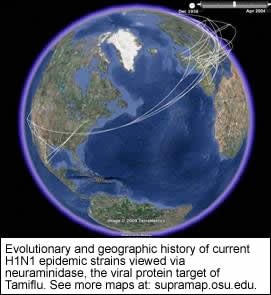An Ohio State University Medical Center biomedical informatics researcher is tapping the power of the Ohio Supercomputer Center to monitor the spread of the H1N1 influenza virus.

Associate professor Daniel Janies, an expert in computational genomics, synthesizes large, diverse datasets to understand the spread of infectious diseases over hosts and geography. The resulting maps can be viewed with Google Earth.
“Currently, we are investigating H1N1 cases from around the world - and Ohio - by building evolutionary trees that discover how this strain came to be assembled and jumped from animals to humans. We are also monitoring viral genomes for mutations that could confer resistance to drugs” Janies said. “Using parallel programming on OSC’s high performance computing systems greatly improves the efficiency of our work.”
With his findings, Janies will project the evolutionary tree of the virus’ mutations and host shifts onto the globe using Supramap, an easy-to-use, web application. He and his colleagues created Supramap in 2007 to track avian influenza. However the underlying technology is applicable to any infectious disease.
“The supercomputer enables us to make comprehensive sets of background data comprised of genomes of viral isolates from all over the world. Large datasets are vitally important to properly understand the host and national origins of each gene in the H1N1 virus causing the outbreak and map its evolution and spread,” Janies said.
“Our ultimate goal is to help predict where the next outbreak of the virus is likely to occur,” he said. “When we’re done, we will be able to tell you where each viral gene came from in the world and what mutations are specific to the outbreak lineage. We then share these tools and maps so that diseases can be diagnosed and treated rapidly.”
OSC recently addressed the growing needs of Ohio’s bioscience and research efforts with a $4 million expansion of its flagship supercomputing system. When the upgrade to the IBM Cluster 1350 is completed this summer, Ohio researchers such as Janies will have access to more than twice the system’s current computing power and memory.
Janies earned his doctorate in zoology at the University of Florida and his bachelor’s degree in biology at the University of Michigan. He was formally trained as a biologist, but as a result of the computational demands of the biological questions he was investigating, he began developing hardware and software. He led the design, construction, and integration of the parallel computing cluster at a previous post with the American Museum of Natural History.
To see interactive visualizations of Janies’ work or make your own maps, go to http://supramap.osu.edu.
_________________
Note to editors: Contact Susan Mantey, susan@osc.edu or 614-688-3949, for electronic images of Daniel Janies or the Supramap screen shot pictured above.
The Ohio Supercomputer Center (OSC) is a catalytic partner of Ohio universities and industries that provides a reliable high performance computing infrastructure for a diverse statewide/regional community including education, academic research, industry, and state government. OSC promotes and stimulates computational research and education in order to act as a key enabler for the state's aspirations in advanced technology, information systems, and advanced industries. For additional information, visit http://www.osc.edu.